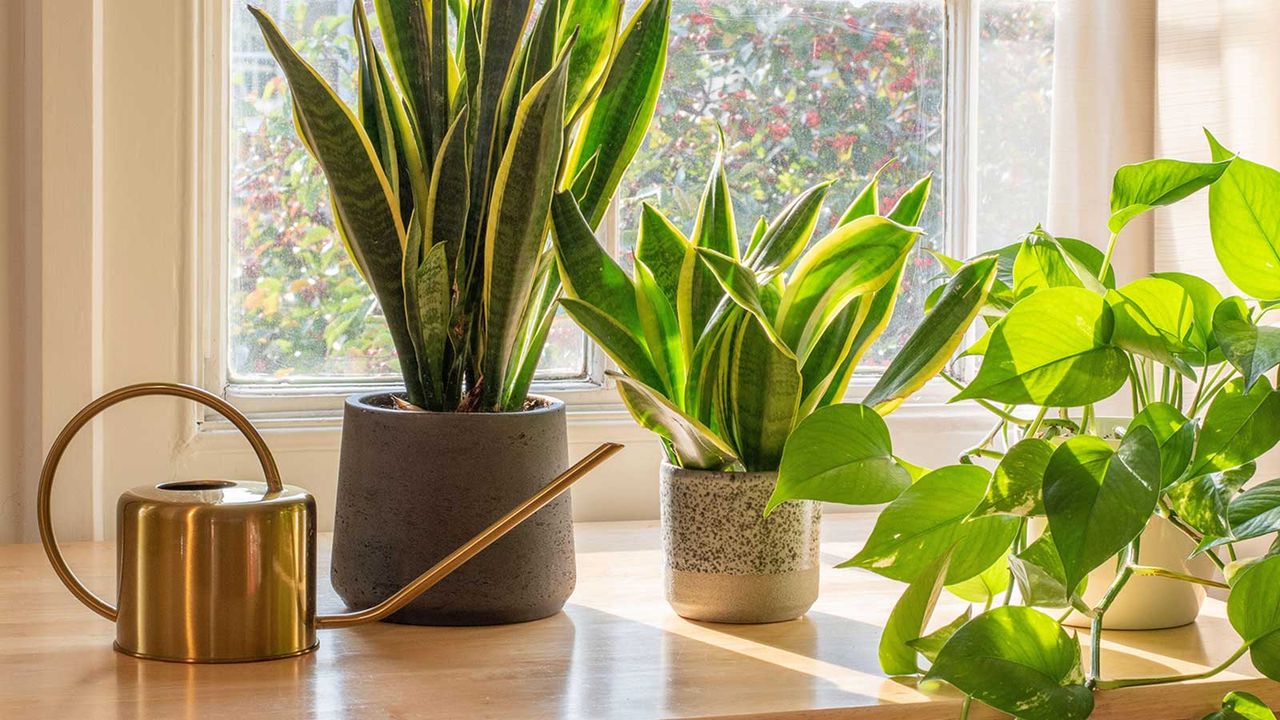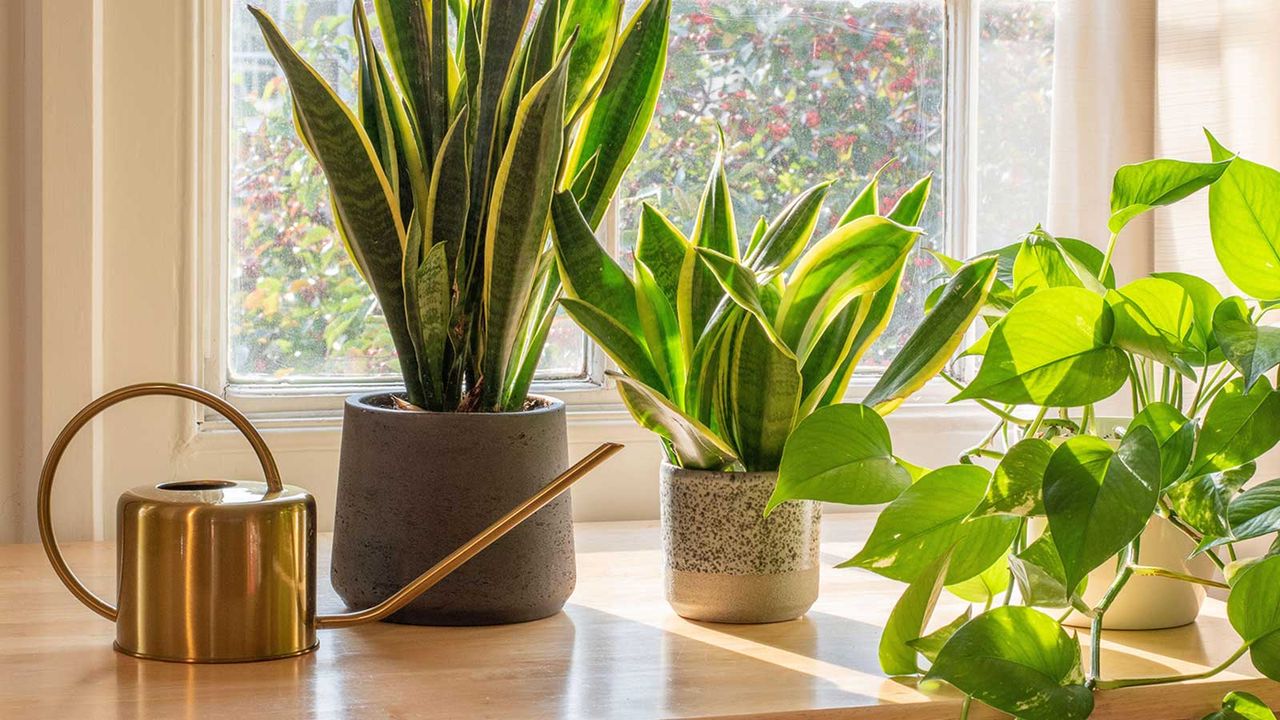Watering Tips for Snake Plants in Different Room Environments is a crucial aspect of keeping these resilient plants thriving. Snake plants, known for their ability to tolerate neglect, still require proper hydration to flourish. Understanding their unique water storage capacity and the influence of room environments on their water needs is key to successful cultivation.
This guide delves into the intricacies of watering snake plants, exploring how temperature, humidity, and light levels affect their water absorption and transpiration rates. We’ll cover various watering techniques, seasonal considerations, and other factors that influence their hydration needs, providing you with the knowledge to tailor your watering practices for optimal growth.
Room Environments and Their Influence
The environment in which your snake plant resides plays a crucial role in its water needs. Factors such as temperature, humidity, and light levels directly impact the plant’s water absorption and transpiration rates. Understanding these influences allows you to adjust watering frequency for optimal plant health.
Room Environment Factors and Their Influence
The following table highlights the key environmental factors that affect snake plant watering:
Room Environment |
Temperature (°F) |
Humidity (%) |
Light Levels |
|---|---|---|---|
Warm and Dry |
70-80°F |
20-30% |
Bright Indirect Light |
Cool and Dry |
60-70°F |
20-30% |
Bright Indirect Light |
Warm and Humid |
70-80°F |
40-50% |
Bright Indirect Light |
Cool and Humid |
60-70°F |
40-50% |
Bright Indirect Light |
Temperature:Warmer temperatures accelerate the plant’s metabolic processes, leading to increased water absorption and transpiration. In warm environments, snake plants require more frequent watering. Conversely, cooler temperatures slow down these processes, reducing water demand.
Humidity:High humidity levels create a more humid environment around the plant, decreasing the rate of transpiration. This means that snake plants in humid environments may need less frequent watering compared to those in dry environments. Low humidity levels increase transpiration, leading to higher water needs.
Watering Snake Plants effectively depends heavily on the specific environment they’re in. A bright, sunny room will likely require more frequent watering than a dimly lit corner. To understand the right watering frequency for your Snake Plant, you’ll need to consider the amount of light it receives, the temperature of the room, and the humidity levels.
A good resource to guide you through this is Snake Plant Watering Tips: How Often Is Right?. Once you understand the basics, you can adjust your watering schedule to suit your specific Snake Plant’s needs and the environment it’s thriving in.
Light Levels:Bright indirect light encourages photosynthesis, a process that consumes water. Snake plants in brighter light conditions generally require more frequent watering compared to those in low-light conditions. However, it’s important to avoid direct sunlight, which can scorch the leaves.
Adjusting Watering Frequency Based on Room Environment
Here are practical tips for adjusting watering frequency based on the specific room environment:
- Warm and Dry Environments:Water more frequently, allowing the soil to dry out slightly between waterings. Consider checking the soil moisture with a finger test or moisture meter to ensure adequate dryness.
- Cool and Dry Environments:Water less frequently, allowing the soil to dry out more thoroughly between waterings. The plant’s slower metabolic rate in cooler temperatures reduces its water needs.
- Warm and Humid Environments:Water moderately, allowing the soil to dry out slightly between waterings. The higher humidity levels slow down transpiration, reducing the need for frequent watering.
- Cool and Humid Environments:Water infrequently, allowing the soil to dry out more thoroughly between waterings. The combined effects of cooler temperatures and higher humidity significantly reduce the plant’s water needs.
Watering Techniques for Optimal Growth
Snake plants are renowned for their resilience and ability to thrive in various environments. However, proper watering is crucial for their optimal growth and health. This section explores different watering techniques, their advantages and disadvantages, and how they relate to different room environments.
Bottom Watering, Watering Tips for Snake Plants in Different Room Environments
Bottom watering involves soaking the plant’s roots by submerging the pot in a container of water. This method allows the soil to absorb water from the bottom up, ensuring even moisture distribution and reducing the risk of overwatering.
- Advantages:
- Ensures even moisture distribution, preventing dry spots in the soil.
- Reduces the risk of overwatering, as the plant only absorbs the water it needs.
- Ideal for snake plants in dry environments, as it allows the soil to absorb water gradually.
- Disadvantages:
- Can be time-consuming, as the pot needs to be submerged for a specific duration.
- May not be suitable for plants in humid environments, as the soil may remain too wet.
To bottom water a snake plant, fill a container with water, ensuring the water level is below the rim of the pot. Submerge the pot for 15-30 minutes, allowing the soil to absorb water. Remove the pot and let it drain thoroughly before returning it to its original location.
Top Watering
Top watering involves pouring water directly onto the soil surface, allowing it to penetrate downwards. This is the most common watering method for snake plants.
- Advantages:
- Simple and convenient, requiring minimal effort.
- Suitable for both dry and humid environments, as the amount of water can be adjusted based on the environment.
- Disadvantages:
- Can lead to uneven moisture distribution, leaving some areas of the soil dry.
- Increases the risk of overwatering, especially in humid environments, as the soil may retain too much moisture.
When top watering, pour water slowly and evenly around the base of the plant, ensuring the entire soil surface is moistened. Avoid overwatering, as this can lead to root rot.
Soaking Method
The soaking method involves thoroughly saturating the soil with water, allowing it to drain completely before watering again. This method mimics the natural rainfall pattern and encourages healthy root development.
- Advantages:
- Promotes deep root growth, leading to a healthier and more robust plant.
- Helps flush out excess salts and minerals from the soil, preventing nutrient imbalances.
- Disadvantages:
- Requires more water than other methods, which can be wasteful.
- May not be suitable for plants in humid environments, as the soil may remain too wet for extended periods.
To soak a snake plant, thoroughly saturate the soil with water, allowing it to drain completely. Repeat this process every 2-4 weeks, depending on the environment and the plant’s needs.
Seasonal Considerations
Snake plants, like most other plants, experience periods of active growth and dormancy influenced by the changing seasons. Understanding these seasonal variations and adjusting watering practices accordingly is crucial for maintaining their health and promoting optimal growth.
Seasonal Watering Recommendations
The watering needs of snake plants fluctuate significantly throughout the year, aligning with their growth cycles and the environmental conditions they experience.
- Spring and Summer: As temperatures rise and daylight hours lengthen, snake plants enter a period of active growth, demanding more water to support their increased metabolic activity. The ideal watering frequency during this time is typically once every 10-14 days, ensuring the soil dries out slightly between waterings.
- Fall and Winter: With shorter days and cooler temperatures, snake plants enter a state of dormancy, reducing their growth rate and water requirements. During these months, it’s essential to reduce watering frequency to once every 3-4 weeks, allowing the soil to dry out more thoroughly between waterings.
Watering Frequency Based on Room Environment
The specific watering frequency for snake plants during different seasons can vary based on the room environment.
Season |
Temperature (°F) |
Humidity (%) |
Watering Frequency |
|---|---|---|---|
Spring |
65-75°F |
40-50% |
Every 10-14 days |
Summer |
75-85°F |
30-40% |
Every 7-10 days |
Fall |
60-70°F |
40-50% |
Every 2-3 weeks |
Winter |
55-65°F |
30-40% |
Every 3-4 weeks |
Note:These are general guidelines, and the actual watering frequency may vary depending on the specific room environment, pot size, and individual plant needs. It’s crucial to observe the plant’s signals and adjust watering practices accordingly.
Additional Factors Affecting Watering
While the room environment plays a significant role in determining the snake plant’s watering needs, other factors can also influence how often you should water your plant. These factors can affect the rate of water absorption, retention, and evaporation, ultimately impacting the plant’s overall hydration.
Pot Size and Material
The size and material of the pot can significantly impact the snake plant’s watering frequency.
- Larger potsoffer more space for the roots to grow and absorb water, leading to less frequent watering. Smaller pots tend to dry out faster, requiring more frequent watering.
- Pots made from porous materials, such as terracotta, allow for better air circulation and faster evaporation, increasing the frequency of watering. Non-porous pots, such as plastic or glazed ceramic, retain moisture longer, requiring less frequent watering.
Soil Type and Drainage
The type of soil used and its drainage properties are crucial for maintaining the snake plant’s moisture balance.
- Well-draining soil, with a mix of potting soil, perlite, and vermiculite, allows excess water to drain freely, preventing root rot.
- Dense soilwith poor drainage can lead to waterlogging, which can suffocate the roots and hinder growth.
Plant Health and Stress
The overall health and stress level of the snake plant can also affect its watering needs.
Watering snake plants in different room environments requires careful consideration. The amount of light a room receives, the temperature, and the humidity all play a role in how often you should water your plant. To avoid overwatering, a key factor is understanding the frequency of watering based on your environment.
For a comprehensive guide on determining the optimal watering schedule, check out this article on How Often to Water a Snake Plant Without Overwatering. Once you’ve established the right watering frequency, you can adjust it slightly based on the specific needs of your snake plant and its environment.
- Healthy plantswith vigorous growth require more frequent watering than stressed plants.
- Stressed plants, which may be experiencing root rot, overwatering, or pest infestations, may need less frequent watering to allow the soil to dry out completely.
Final Summary: Watering Tips For Snake Plants In Different Room Environments

By understanding the nuances of watering snake plants in different room environments, you can create the perfect balance of moisture for these hardy plants. From adjusting watering frequency based on seasonal changes to selecting the right watering method for your specific conditions, this guide provides practical tips and insights to help you cultivate healthy and vibrant snake plants.
Expert Answers
How often should I water my snake plant?
The frequency of watering depends on various factors, including the plant’s size, growth stage, and the room environment. Generally, allow the soil to dry out completely between waterings, typically every 2-4 weeks.
What are the signs of overwatering a snake plant?
Overwatering is evident by yellowing leaves, soft stems, and a musty smell from the soil. It’s essential to let the soil dry out thoroughly between waterings to prevent root rot.
Can I use tap water to water my snake plant?
While tap water is generally suitable, it’s best to let it sit for 24 hours to allow chlorine and other chemicals to evaporate. Using filtered or rainwater is also beneficial.
